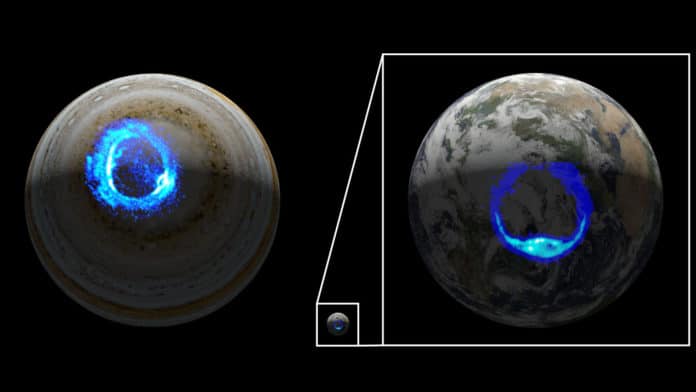Jupiter displays many distinct auroral structures, among which auroral dawn storms and auroral injections are often observed contemporaneously. However, what causes auroral dawn storms remains uncertain.
Hubble’s Faint Object Camera in 1994, these dawn storms occur at both Jovian poles. It consists of short-lived but intense brightening and broadening of Jupiter’s main auroral oval near where the atmosphere emerges from the darkness in the early morning region.
Explorations by other spacecraft – Voyager, Galileo, Cassini – happened from relatively large distances and did not fly over the poles, so they could not see the complete picture. New results from the Ultraviolet Spectrograph instrument on NASA‘s Juno mission reveal the birth of auroral dawn storms for the first time.
The observations revealed that the dawn storms are born on the nightside of the gas giant. The dawn storm rotates with a rotating planet into the dayside, where these complex and intensely bright auroral features grow even more luminous.
As a result, the storm emits from hundreds to thousands of ultraviolet light gigawatts into space. What’s more, it dumps at least ten times more energy into Jupiter‘s upper atmosphere than typical aurora.
Zhonghua Yao, a co-author of the study at the University of Liège, said, “When we looked at the whole dawn storm sequence, we couldn’t help but notice that they are very similar to a type of terrestrial auroras called substorms.”
The findings allow scientists to get detailed insights on the differences and similarities driving the formation of the aurora, providing a better understanding of how these most beautiful planetary phenomena occur on worlds both within our solar system and beyond.
Scott Bolton, principal investigator of Juno from the Southwest Research Institute in San Antonio, said, “The power that Jupiter possesses is amazing. The energy in these dawn aurorae is yet another example of how powerful this giant planet is. The dawn storm revelations are another surprise from the Juno mission, which is constantly rewriting the book on how giant planets work. With NASA’s recent mission extension, we’re looking forward to many more new insights and discoveries.”
Journal Reference:
- B. Bonfond et al., Are Dawn Storms Jupiter’s Auroral Substorms? AGU Advances, First published: 16 March 2021 DOI: 10.1029/2020AV000275
